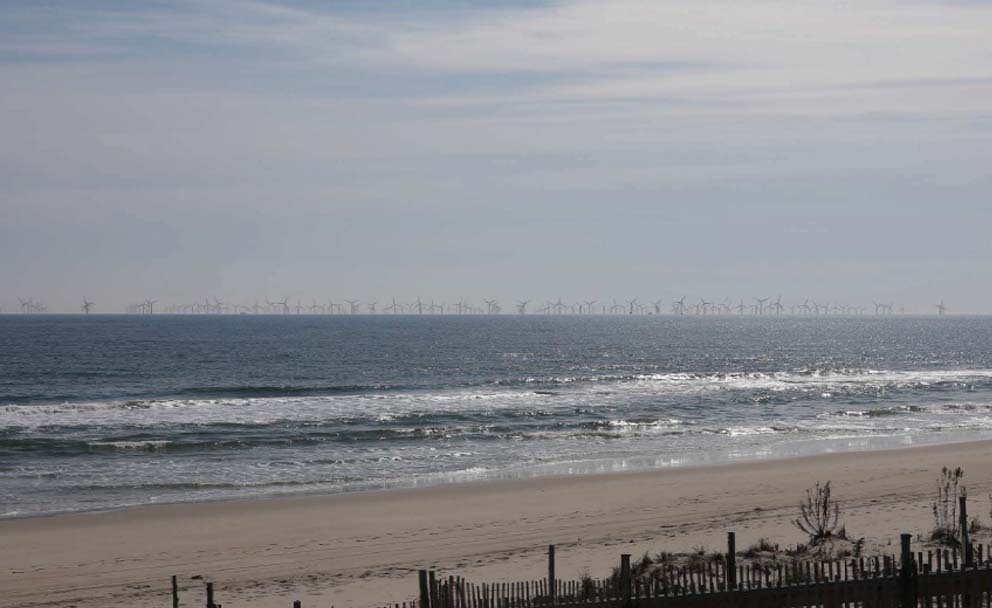LONG BEACH ISLAND, NJ – As Long Beach Island communities have united in a legal battle against Phil Murphy’s proposed off-shore wind farm, lawyers representing the towns released a photo showing what the view will look like from the shoreline.
The photo is a rendering of a beach view showing how the wind turbines will appear from the beach. Many other towns have expressed verbal opposition to the offshore wind project citing many issues including declines in tourism, negative impacts on the local fishing economies and possible harmful effects of the massive project on sea life, including whales and dolphins.
The newly released photo rendering shows the ocean view from Centre Street in Beach Haven.
Pashman Stein Walder Hayden, representing Long Beach Island Municipalities, has submitted a comment letter to the New Jersey Department of Environmental Protection (NJDEP) regarding the Atlantic Shores Offshore Wind project. The letter raises concerns about the project’s compliance with coastal policies and its potential negative effects on the environment and local economy. The filing was made on behalf of Long Beach Township, Beach Haven, Ship Bottom, Barnegat Light, Surf City, and Harvey Cedars, collectively representing all municipalities on Long Beach Island.
Frank Huttle, Partner at Pashman Stein Walder Hayden, stated that the comment letter highlights the project’s failure to adhere to NJDEP’s coastal zone management regulations. Huttle argues that the NJDEP should deny Atlantic Shores’ request and encourage the company to seek approval for a project in a designated lease area further offshore, which would minimize the impact on coastal resources and the economy.
Michael S. Stein, Chair and Managing Partner of Pashman Stein, emphasized that while the LBI Municipalities support renewable energy and wind power, the Atlantic Shores project is deeply flawed. Stein believes that the project has undergone a rushed evaluation process and lacks a thorough assessment of its environmental and economic consequences. The comment letter argues that the project contradicts New Jersey’s coastal policies and calls for additional studies based on up-to-date data.
Long Beach Township Mayor Joseph H. Mancini expressed the municipalities’ recognition of the need for clean energy resources and their support for offshore wind development. However, Mancini emphasized that the specific Atlantic Shores project must be halted due to its potential to devastate the coastal resources and economy of the LBI Municipalities. Mancini explained that the comment letter represents the unified voice of the municipalities’ leaders, advocating for the protection of residents, visitors, and businesses affected by the project.
Highlighting the unique characteristics of Long Beach Island, Huttle underscored the diverse year-round businesses, residential communities, pristine beaches, tourism, and commercial fishing that would be jeopardized by the Atlantic Shores project. The island is home to protected sand dunes, bird refuges, and a historic state park, making it a vital ecological and recreational area.
Expressing skepticism regarding the NJDEP’s response to the comments, Mancini voiced concerns over the department’s perceived inclination to approve offshore wind projects. He cited comments made by NJDEP Commissioner Shawn LaTourette, which seemed to dismiss any link between whale deaths and offshore wind projects. Mancini asserted that the LBI Municipalities would explore all available options, including pursuing an adjudicatory hearing and seeking judicial review, to safeguard Long Beach Island for future generations.
The comment letter provides several reasons for opposing the Atlantic Shores project. It highlights that the project would be the largest of its kind in the United States, with 200 windmills over 1,000 feet tall situated as close as 8.7 miles from shore. The visual impact of the wind farm and its violation of NJDEP rules protecting scenic resources are emphasized. A photo simulation created by the federal Bureau of Ocean Energy Management is included to illustrate the potential transformation of ocean vistas on Long Beach Island.
Studies referenced in the letter indicate that placing turbines too close to shore leads to decreased tourism, with up to 43% of beachgoers choosing alternative destinations to avoid the turbines. Economic impacts are significantly mitigated when turbines are located more than 15 miles offshore, and the letter suggests an open lease area 30 miles offshore as a viable alternative to eliminate visual impacts.

